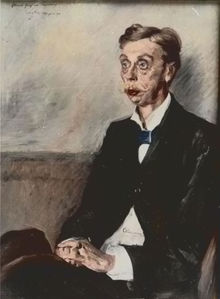In the quiet corner
In the quiet corner is a story by Eduard von Keyserling that appeared in 1918 in “Fischer's Library of Contemporary Novels” in Berlin. It had previously been published in Velhagen & Klasings monthly magazines as early as 1917 .
Summary: The war not only destroys lives at the front, but also at home.
action
The family of bank director Bruno von Ost spent the summer of 1914 in the old villa on the edge of the village in the mountains. The director accompanies his wife Irene and little Paul on the train to the resort. The young Hugo von Wirden, a trainee in the bank, makes advances to the wife - much to the annoyance of the director. Paul, quickly despondent, has to overhear an argument between his parents in the villa that evening. Von Wirden's father scolds a greyhound that he doesn't want to see near his wife. Mrs. von Ost holds against it. In general, she disgusts the constant correctness of the bank director.
Then the First World War breaks out. From east and from Wirden follow the call into the field. Before that, they both arrive at the villa one after the other and say goodbye to the family. Von Ost has arranged everything just in case and moves in. Then von Wirden appears and confesses his love to Mrs. Irene. In his situation, he takes the right to make Irene a loving woman. The proud and aloof feels like a cat in love.
Director of East falls. Mrs. Irene changes from a cat in love to a widow who mourns Paul's “good, noble father”. Officer von Wirden - only available from the front for a short time - stops by the villa, cannot comfort Irene and is turned away.
Even little Paul becomes a different person after the death of his father. Because of his despondency by Lulu, the little son of Major Welker, constantly teased, by his girlfriend, little Nandl - that is the church farmer's daughter - he shows his courage and dies - just like the soldiers outside: Paul gets up the way to the enemy. In the mountain forest he gets caught in a thunderstorm. A terrible lightning bolt strikes in the immediate vicinity. Paul dies of the consequences a little later in the villa.
Form and interpretation
The narrator usually stays very close to the worried little Paul. It follows that the narrator is not omniscient. For example, if Paul doesn't understand a verbatim speech, the narrator won't convey it either. Through this narrative technique, the text gets a glimpse into the psyche of a child who cannot grasp the "bloody madness" of war. So it's not about the hypocritical adults - like Paul's mother Irene, for example - but primarily about Paul's attempts to overcome his childish fears.
If von Keyserling was always an admirable portrayal of native Baltic landscapes, he shines here in one of his last works as a connoisseur of the Upper Bavarian forest wilderness.
reception
Sprengel calls this work “marginal”.
Used edition
- In the quiet corner. P. 7–70 in: Eduard von Keyserling: In the quiet angle. Nicky . Two stories. Fischer Taschenbuch, Frankfurt am Main 1983, ISBN 3-596-25354-3
literature
- Peter Sprengel : History of German-Language Literature 1900–1918. Munich 2004, ISBN 3-406-52178-9
- Gero von Wilpert : Lexicon of world literature. German authors A – Z. Stuttgart 2004, ISBN 3-520-83704-8 , p. 331, right column, 11. Zvo
Individual evidence
- ↑ Edition used, p. 4, 1. Zvo
- ↑ Steffen Brondke: Journal and book prints of the literary texts Keyserling . In: Christoph Juergensen, Michael Scheffel (Ed.): Eduard von Keyserling and the classical modern . JB Metzler, Stuttgart 2020, ISBN 978-3-476-04891-2 , p. 287–290 , doi : 10.1007 / 978-3-476-04892-9_19 ( springer.com [accessed April 3, 2020]).
- ↑ Edition used, p. 118, 10. Zvo (Nicky)
- ^ Sprengel, p. 359, 1. Zvo
- ↑ The edition used contains printing errors - see for example p. 56, 8. Zvu and also p. 69, 13. Zvo
